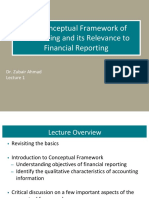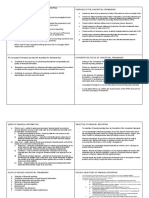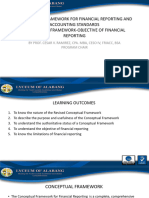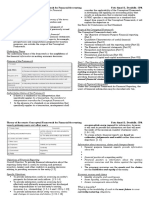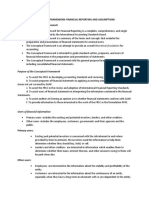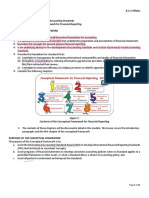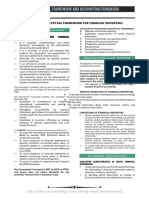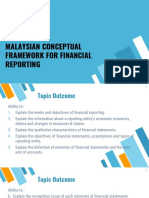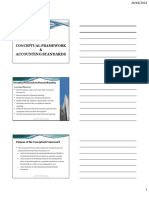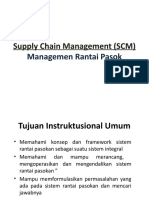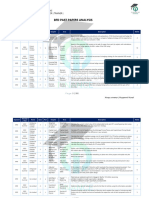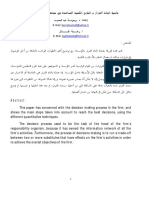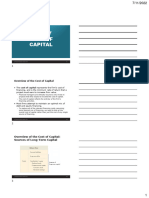UNIT II
CONCEPTUAL FRAMEWORK FOR FINANCIAL REPORTING
(2018 VERSION)
INTRODUCTION
The International Accounting Standards Board (Board) issued the revised Conceptual
Framework for Financial Reporting (Conceptual Framework), a comprehensive set of
concepts for financial reporting, in March 2018. It sets out, the objective of financial
reporting; the qualitative characteristics of useful financial information; a description of
the reporting entity and its boundary; definitions of an asset, a liability, equity, income
and expenses; criteria for including assets and liabilities in financial statements
(recognition) and guidance on when to remove them (derecognition); measurement
bases and guidance on when to use them; and concepts and guidance on presentation
and disclosure.
LEARNING OBJECTIVES
After reading this unit, you should be able to:
1. State the purpose and status of the conceptual framework for financial reporting.
2. Explain the objective of the general-purpose financial reporting and the
information needs of its users.
3. Enumerate the qualitative characteristics of useful financial information and
illustrate their application.
4. Explain what a reporting entity is.
5. Illustrate the application of the going concern assumption and accrual basis of
accounting.
6. Define the elements of the financial statements and explain the criteria for their
recognition and the bases for their measurement.
7. Discuss the concepts applied for derecognition of assets and liabilities.
8. Explain how an entity can effectively communicate its financial information
through financial statement presentation and disclosure.
9. Discuss the two concepts of capital and the two concepts of capital maintenance.
LECTURE DISCUSSION
STATUS AND PURPOSE OF THE CONCEPTUAL FRAMEWORK
The Conceptual Framework for Financial Reporting (Conceptual Framework) describes
the objective of, and the concepts for, general purpose financial reporting. The purpose
of the Conceptual Framework is to:
a. Assist the International Accounting Standards Board (Board) to develop IFRS
Standards (Standards) that are based on consistent concepts;
b. assist preparers to develop consistent accounting policies when no Standard
30
� applies to a particular transaction or other event, or when a Standard allows a
choice of accounting policy; and
c. assist all parties to understand and interpret the Standards.
The Conceptual Framework is not a Standard. Nothing in the Conceptual Framework
overrides any Standard or any requirement in a Standard. To meet the objective of
general- purpose financial reporting, the Board may sometimes specify requirements
that depart from aspects of the Conceptual Framework. If the Board does so, it will
explain the departure in the Basis for Conclusions on that Standard.
OBJECTIVE, USEFULNESS AND LIMITATIONS OF GENERAL-PURPOSE
FINANCIAL REPORTING
The objective of general-purpose financial reporting forms the foundation of the
Conceptual Framework. Other aspects of the Conceptual Framework—the qualitative
characteristics of, and the cost constraint on, useful financial information, a reporting
entity concept, elements of financial statements, recognition and derecognition,
measurement, presentation and disclosure—flow logically from the objective.
The objective of general-purpose financial reporting is to provide financial information
about the reporting entity that is useful to existing and potential investors, lenders and
other creditors in making decisions relating to providing resources to the entity. Those
decisions involve decisions about:
a. buying, selling or holding equity and debt instruments;
b. providing or settling loans and other forms of credit; or
c. exercising rights to vote on, or otherwise influence, management’s actions that
affect the use of the entity’s economic resources.
The decisions described depend on the returns that existing and potential investors,
lenders and other creditors expect, for example, dividends, principal and interest
payments or market price increases. Investors’, lenders’ and other creditors’
expectations about returns depend on their assessment of the amount, timing and
uncertainty of (the prospects for) future net cash inflows to the entity and on their
assessment of management’s stewardship of the entity’s economic resources. Existing
and potential investors, lenders and other creditors need information to help them make
those assessments. To make the assessments described, existing and potential
investors, lenders and other creditors need information about:
a. the economic resources of the entity, claims against the entity and changes in
those resources and claims; and
b. how efficiently and effectively the entity’s management and governing board have
discharged their responsibilities to use the entity’s economic resources.
Many existing and potential investors, lenders and other creditors cannot require
reporting entities to provide information directly to them and must rely on general
purpose financial reports for much of the financial information they need.
Consequently,theyaretheprimaryuserstowhomgeneral purpose financial reports are
directed. To a large extent, financial reports are based on estimates, judgements and
31
�models rather than exact depictions. The Conceptual Framework establishes the
concepts that underlie those estimates, judgements and models. The concepts
arethegoaltowardswhichtheBoardandpreparersoffinancialreportsstrive.Aswithmostgoals,
theConceptualFramework’svisionofidealfinancialreportingisunlikelytobeachievedinfull,at
leastnotintheshortterm,becauseittakestimetounderstand,acceptandimplementnewways
of analyzing transactions and other events. Nevertheless, establishing a goal towards
which to strive is essential if financial reporting is to evolve to improve its usefulness.
ECONOMICRESOURCESANDCLAIMS
Informationaboutthenatureandamountsofareportingentity’seconomicresourcesand
claims can help users to identify the reporting entity’s financial strengths and
weaknesses. That information can help users to assess the reporting entity’s liquidity
and solvency, its needs for additional financing and how successful it is likely to be in
obtaining that financing. That information can also help users to assess management’s
stewardship of the entity’s economic resources. Information about priorities and
payment requirements of existing claims helps users
topredicthowfuturecashflowswillbedistributedamongthosewithaclaimagainstthereporting
entity.
CHANGESINECONOMICRESOURCESANDCLAIMS
Changes in a reporting entity’s economic resources and claims result from that entity’s
financial performance and from other events or transactions such as issuing debt or
equity instruments. To properly assess both the prospects for future net cash inflows to
the reporting entity andmanagement’s stewardship ofthe entity’s economic resources,
users needto be able to identify those two types of changes.
FINANCIALPERFORMANCEREFLECTEDBYACCRUALACCOUNTING
Accrualaccountingdepictstheeffectsoftransactionsandothereventsandcircumstances
onareportingentity’seconomicresourcesandclaimsintheperiodsinwhichthoseeffectsoccur,
even if the resulting cash receipts and payments occur in a different period. This is
important
becauseinformationaboutareportingentity’seconomicresourcesandclaimsandchangesinit
s
economicresourcesandclaimsduringaperiodprovidesabetterbasisforassessingtheentity’s
past and future performance than information solely about cash receipts and payments
during that period.
QUALITATIVECHARACTERISTICSOFUSEFULFINANCIALINFORMATION
The qualitative characteristics of useful financial information discussed in this chapter
identify the types of information that are likely to be most useful to the existing and
potential
investors,lendersandothercreditorsformakingdecisionsaboutthereportingentityonthebasis
of information in its financial report (financial information). Financial reports provide
information
aboutthereportingentity’seconomicresources,claimsagainstthereportingentityandtheeffec
ts of transactions and other events and conditions that change those resources and
32
�claims. (This information is referred to in the Conceptual Framework as information
about the economic phenomena.) Some financial reports also include explanatory
material about management’s
expectationsandstrategiesforthereportingentity,andothertypesofforward-
lookinginformation. If financialinformation isto beuseful, it must berelevant
andfaithfullyrepresentwhat it purports to represent. The usefulness of financial
information is enhanced if it is comparable, verifiable, timely and understandable.
FUNDAMENTALQUALITATIVECHARACTERISTICS
RELEVANCE
Relevant financial information can make a difference in the decisions made by users.
Information may be capable of making a difference in a decision even if some users
choose not to take advantage of it or are already aware of it from other sources.
Financial information can make a difference in decisions if it has predictive value,
confirmatory value or both.
FAITHFULREPRESENTATION
Financial reports represent economic phenomena in words and numbers. To be useful,
financial information must not only represent relevant phenomena, but it must also
faithfully represent thesubstanceof the phenomenathat itpurportstorepresent. Inmany
circumstances, the substance of an economic phenomenon and its legal form are the
same. If they are not the
same,providinginformationonlyaboutthelegalformwouldnotfaithfullyrepresenttheeconomi
c phenomenon. To be a perfectly faithful representation, a depiction would have three
characteristics.Itwouldbecomplete,neutralandfreefromerror.Ofcourse,perfectionisseldom
, if ever, achievable. The Board’s objective is to maximize those qualities to the extent
possible.
ENHANCINGQUALITATIVECHARACTERISTICS
Comparability,verifiability,timelinessandunderstandabilityarequalitativecharacteristics
that enhance the usefulness of information that both is relevant and provides a faithful
representationofwhatitpurportstorepresent.Theenhancingqualitativecharacteristicsmayal
so
helpdeterminewhichoftwowaysshouldbeusedtodepictaphenomenonifbothareconsidered
toprovideequallyrelevantinformationandanequallyfaithfulrepresentationofthatphenomeno
n.
COMPARABILITY
Users’decisionsinvolvechoosingbetweenalternatives,forexample,sellingorholdingan
investment, or investing in one reporting entity or another. Consequently, information
about a reporting entity is more useful if it can be compared with similar information
about other entities and with similar information about the same entity for another period
or another date. Comparability is the qualitative characteristic that enables users to
identify and understand similarities in, and differences among, items. Unlike the other
33
�qualitative characteristics, comparability does not relate to a single item. A comparison
requires at least two items.
VERIFIABILITY
Verifiability helps assure users that information faithfully represents the economic
phenomena it purports to represent. Verifiability means that different knowledgeable
and independent observers could reach consensus, although not necessarily complete
agreement, that a depiction is a faithful representation. Quantified information need not
be a single point estimate to be verifiable. A range of possible amounts and the related
probabilities can also be verified.
TIMELINESS
Timeliness means having information available to decision-makers in time to be capable
ofinfluencingtheirdecisions.Generally,theoldertheinformationisthelessusefulitis.However,
some informationmaycontinue tobetimely longafterthe end of areporting period
because,for example, some users may need to identify and assess trends.
UNDERSTANDABILITY
Classifying, characterizing and presenting information clearly and concisely makes it
understandable. Financial reports are prepared for users who have a reasonable
knowledge of
businessandeconomicactivitiesandwhoreviewandanalyzetheinformationdiligently.Attime
s, even well-informed and diligent users may need to seek the aid of an adviser to
understand information about complex economic phenomena.
THECOSTCONSTRAINTONUSEFULFINANCIALREPORTING
Cost is a pervasive constraint on the information that can be provided by financial
reporting. Reporting financial information imposes costs, and it is important that those
costs are
justifiedbythebenefitsofreportingthatinformation.Thereareseveraltypesofcostsandbenefit
s to consider.
FINANCIALSTATEMENTS
Financialstatementsprovideinformationabouteconomicresourcesofthereportingentity,
claimsagainsttheentity,andchangesinthoseresourcesandclaims,thatmeetthedefinitionsof
the elements of financialstatements. The objective offinancial statementsis to provide
financial information about the reporting entity’s assets, liabilities, equity, income and
expenses that is useful to users of financial statements in assessing the prospects for
future net cash inflows to the reporting entity and in assessing management’s
stewardship of the entity’s economic resource. That information is provided:
a. inthestatementoffinancialposition,byrecognizingassets,liabilitiesandequity;
b. inthestatement(s)offinancialperformance,byrecognizingincomeand expenses; and
c. inotherstatementsandnotes,bypresentinganddisclosinginformationabout:
i. recognizedassets,liabilities,equity,incomeandexpenses,includinginformatio
n about their nature and about the risks arising from those recognized
34
� assets and liabilities;
ii. assets and liabilities that have not been recognized, including information
about their nature and about the risks arising from them;
iii. cashflows;
iv. contributionsfromholdersofequityclaimsanddistributionstothem;and
v. the methods, assumptions and judgements used in estimating the
amounts presented or disclosed, and changes in those methods,
assumptions and judgements.
REPORTINGPERIOD
Financial statements are prepared for a specified period of time (reporting period)
andprovide information about:
a. assets and liabilities—including unrecognized assets and liabilities—and equity
that existed at the end of the reporting period, or during the reporting period; and
b. incomeandexpensesforthereportingperiod.
Tohelp users offinancialstatementsto identify andassess changes and trends,financial
statements also provide comparative information for at least one preceding reporting
period.
GOINGCONCERNASSUMPTION
Financialstatementsarenormally preparedonthe assumptionthat thereportingentityis a
going concern and will continue in operation for the foreseeable future. Hence, it is
assumed
thattheentityhasneithertheintentionnortheneedtoenterliquidationortoceasetrading.Ifsuch
anintentionorneedexists,thefinancialstatementsmayhavetobepreparedonadifferentbasis.
If so, the financial statements describe the basis used.
THEELEMENTSOFFINANCIALSTATEMENTS
35
�Anassetisapresenteconomicresourcecontrolledbytheentityasaresultofpastevents.
Aneconomicresourceisarightthathasthepotentialtoproduceeconomicbenefits.Thissection
discusses three aspects of those definitions:
a. right;
b. potentialtoproduceeconomicbenefits;and
c. control.
Aliabilityisapresentobligationoftheentitytotransfer aneconomicresourceasaresult of past
events. For a liability to exist, three criteria must all be satisfied:
a. theentityhasanobligation;
b. theobligationistotransferaneconomicresource;and
c. theobligationisapresentobligationthatexistsasaresultofpastevents.
Equity is the residual interest in the assets of the entity after deducting all its liabilities.
Equity claims are claims on the residual interest in the assets of the entity after
deducting all its liabilities. In other words, they are claims against the entity that do not
meet the definition of a
liability.Suchclaimsmaybeestablishedbycontract,legislationorsimilarmeans,andinclude,to
the extent that they do not meet the definition of a liability:
a. sharesofvarioustypes,issuedbytheentity;and
b. someobligationsoftheentitytoissueanotherequityclaim.
36
�Incomeisincreasesinassets,ordecreasesinliabilities,thatresultinincreasesinequity, other
than those relating to contributions from holders of equity claims.
Expenses are decreases in assets, or increases in liabilities, that result in decreases in
equity, other than those relating to distributions to holders of equity claims.
Income and expenses are the elements of financial statements that relate to an entity’s
financial performance. Users of financial statements need information about both an
entity’s financial position and its financial performance. Hence, although income and
expenses are defined in terms of changes in assets and liabilities, information about
income and expenses is just as important as information about assets and liabilities.
THERECOGNITIONPROCESS
Recognition is the process of capturing for inclusion in the statement offinancial position
or the statement(s) of financial performance an item that meets the definition of one of
the elements of financial statements—an asset, a liability, equity, income or expenses.
Recognition involves depictingtheitem in one ofthose statements—either alone or
inaggregationwith other items—in words and by a monetary amount and including that
amount in one or more totals in that statement. The amount at which an asset, a liability
or equity is recognized in the statement of financial position is referred to as its ‘carrying
amount’.
The statement of financial position and statement(s) of financial performance depict an
entity’s recognized assets, liabilities, equity, income and expenses in structured
summaries that
aredesignedtomakefinancialinformationcomparableandunderstandable.Animportantfeat
ure of thestructures of thosesummaries isthat the amounts recognizedin astatement
areincluded in the totals and, if applicable, subtotals that link the items recognized in the
statement.
Recognitionlinkstheelements;thestatementoffinancialpositionandthestatement(s)of
financial performance as follows:
a. inthestatementoffinancialpositionatthebeginningandendofthereportingperiod, total
assets minus total liabilities equal total equity; and
b. recognizedchangesinequityduringthereportingperiodcomprise:
i. income minus expenses recognized in the statement(s) of financial
performance; plus
ii. contributions from holders of equity claims, minus distributions to holders
of equity claims.
Thestatementsarelinkedbecausetherecognitionofoneitem(orachangeinitscarrying
amount) requires the recognition or derecognition of one or more other items (or
changes in the carrying amount of one or more other items). For example:
a. therecognitionofincomeoccursatthesametimeas:
i. the initial recognition of an asset, or an increase in the carrying
37
� amount of an asset; or
ii. thederecognitionofaliability,oradecreaseinthecarryingamountofaliabili
ty.
b. therecognitionofexpensesoccursatthesametimeas:
i. the initial recognition of a liability, or an increase in the carrying
amount of aliability; or
ii. thederecognitionofanasset,oradecreaseinthecarryingamountofanass
et.
Recognitioncriteria
Only items that meet the definition of an asset, a liability or equity are recognized in the
statementoffinancialposition.Similarly,onlyitemsthatmeetthedefinitionofincomeorexpense
s
arerecognizedinthestatement(s)offinancialperformance.However,notallitemsthatmeetthe
definition of one of those elements are recognized. Not recognizing an item that meets
the definition of one of the elements makes the statement of financial position and the
statement(s) of financial performance less complete and can exclude useful information
from financial statements. On the other hand, in some circumstances, recognizing some
items that meet the definition of one of the elements would not provide useful
information. An asset or liability is recognized only if recognition of that asset or liability
and of any resulting income, expenses or changes in equity provides users of financial
statements with information that is useful.
DERECOGNITION
Derecognitionistheremovalofallorpartofarecognizedassetorliabilityfromanentity’s
statementoffinancialposition.Derecognitionnormallyoccurswhenthatitemnolongermeetsth
e definition of an asset or of a liability:
a. for an asset, derecognition normally occurs when the entity loses control of all or
38
� part of the recognized asset; and
b. for a liability, derecognition normally occurs when the entity no longer has a
present obligation for all or part of the recognized liability.
MEASUREMENTBASES
Elements recognized in financial statements are quantified in monetary terms. This
requirestheselectionofameasurementbasis.Ameasurementbasisisanidentifiedfeature—
for example, historical cost, fair value or fulfilment value—of an item being measured.
Applying a measurement basis to an asset or liability creates a measure for that asset
or liability and for related income and expenses.
HISTORICALCOST
Historicalcostmeasuresprovidemonetaryinformationaboutassets,liabilitiesandrelated
incomeandexpenses,usinginformationderived,atleastinpart,fromthepriceofthetransaction
orothereventthatgaverisetothem.Unlikecurrentvalue,historicalcostdoesnotreflectchanges
in values, except to the extent that those changes relate to impairment of an asset or a
liability becoming onerous.
CURRENTVALUE
Currentvaluemeasuresprovidemonetaryinformationaboutassets,liabilitiesandrelated
income and expenses, usinginformationupdatedto reflect conditions atthemeasurement
date. Because of the updating, current values of assets and liabilities reflect changes,
since the
previousmeasurementdate,inestimatesofcashflowsandotherfactorsreflectedinthosecurre
nt values. Unlikehistoricalcost,thecurrent valueofanassetorliabilityisnot
derived,eveninpart,
fromthepriceofthetransactionorothereventthatgaverisetotheassetorliability.Currentvalue
measurement bases include:
a. fairvalue;
b. valueinuseandfulfilmentvalueforliabilities;and
c. currentcost
MEASUREMENTOFEQUITY
The total carrying amount of equity (total equity) is not measured directly. It equals the
total of thecarrying amounts of allrecognized assets lessthetotalof thecarrying amounts
of all recognized liabilities.
PRESENTATIONANDDISCLOSUREASCOMMUNICATIONTOOLS
A reporting entity communicates information about its assets, liabilities, equity, income
and expenses by presenting and disclosing information in its financial statements.
Effective communication of information in financial statements makes that information
more relevant and contributes to a faithful representation of an entity’s assets, liabilities,
equity, income and expenses. It also enhances the understandability and comparability
of information in financial statements.Just as cost constrains other financial reporting
decisions, it also constrains
decisionsaboutpresentationanddisclosure.Hence,inmakingdecisionsaboutpresentationa
39
�nd disclosure, it is important to consider whether the benefits provided to users of
financial statements by presenting or disclosing particular information are likely to justify
the costs of providing and using that information.
CLASSIFICATION
Classification is the sorting of assets, liabilities, equity, income or expenses based on
shared characteristics for presentation and disclosure purposes. Such characteristics
include— but are not limited to—the nature of the item, its role (or function) within the
business activities conducted by the entity, and how it is measured.
CLASSIFICATIONOFASSETSANDLIABILITIES
Classificationisappliedtotheunitofaccountselectedforanassetorliability.However,it
maysometimesbeappropriatetoseparateanassetorliabilityintocomponentsthathavediffere
nt characteristics and to classify those components separately. That would be
appropriate when classifyingthosecomponentsseparatelywould
enhancetheusefulnessoftheresultingfinancial
information.Forexample,itcouldbeappropriatetoseparateanassetorliabilityintocurrentand
non-current components and to classify those components separately.
OFFSETTING
Offsetting occurs when an entity recognizes and measures both an asset and liability as
separate units ofaccount, but groups them into asingle net amount in thestatement
offinancial
position.Offsettingclassifiesdissimilaritemstogetherandthereforeisgenerallynotappropriat
e.
CLASSIFICATIONOFEQUITY
To provide useful information, it may be necessary to classify equity claims separately if
those equity claims have different characteristics
CLASSIFICATIONOFINCOMEANDEXPENSES
Classificationisappliedto:
a. incomeandexpensesresultingfromtheunitofaccountselectedforanassetorliability; or
b. components of such income and expenses if those components have different
characteristicsandareidentifiedseparately.Forexample,achangeinthecurrentvalue
ofanassetcanincludetheeffectsofvaluechangesandtheaccrualofinterest.Itwould be
appropriate to classify those components separately if doing so would enhance
the usefulness of the resulting financial information.
PROFITORLOSSANDOTHERCOMPREHENSIVEINCOME
Incomeandexpensesareclassifiedandincludedeither:
a. inthestatementofprofitorloss;or
b. outsidethestatementofprofitorloss,inothercomprehensiveincome.
The statement of profit or loss is the primary source of information about an entity’s
financial performance for the reporting period. That statement contains a total for profit
40
�or loss that provides a highly summarized depiction of the entity’s financial performance
for the period.
Manyusersoffinancialstatementsincorporatethattotalintheiranalysiseitherasastartingpoint
for that analysis or as the main indicator of the entity’s financial performance for the
period.
Nevertheless,understandinganentity’sfinancialperformancefortheperiodrequiresananalys
is of all recognized income and expenses—including income and expenses included in
other comprehensive income—as well as an analysis of other information included in
the financial statements.
AGGREGATION
Aggregation is the adding together of assets, liabilities, equity, income or expenses that
have shared characteristics and are included in the same classification. Aggregation
makes
informationmoreusefulbysummarizingalargevolumeofdetail.However,aggregationconcea
ls some of that detail. Hence, a balance needs to be found so that relevant information
is not obscured either by a large amount of insignificant detail or by excessive
aggregation.
CONCEPTSOFCAPITAL
A financial concept of capital is adopted by most entities in preparing their financial
statements.Underafinancialconceptofcapital,suchasinvestedmoneyorinvestedpurchasin
g
power,capitalissynonymouswiththenetassetsorequityoftheentity.Underaphysicalconcept
ofcapital,suchasoperatingcapability,capitalisregardedastheproductivecapacityoftheentity
based on, for example, units of output per day.
CONCEPTSOFCAPITALMAINTENANCEANDTHEDETERMINATIONOFPROFIT
The concepts of capital give rise to the following concepts of capital maintenance:
a. Financialcapitalmaintenance.Underthisconceptaprofitisearnedonlyifthefinancial
(or money) amount of the net assets at the end of the period exceedsthefinancial
(or money) amount of net assets at the beginning of the period, after excluding
any distributions to, and contributions from, owners during the period. Financial
capital maintenance can be measured in either nominal monetary units or units
of constant purchasing power.
b. Physicalcapitalmaintenance. Underthisconceptaprofitisearnedonlyifthephysical
productive capacity (or operating capability) of the entity (or the resources or
funds needed to achieve that capacity) at the end of the period exceeds the
physical productivecapacity at the beginning of the period, after excluding any
distributions to, and contributions from, owners during the period.
The concept of capital maintenance is concerned with how an entity defines the capital
thatitseekstomaintain.Itprovidesthelinkagebetweentheconceptsofcapitalandtheconcepts
ofprofitbecauseitprovidesthepointofreferencebywhichprofitismeasured;itisaprerequisite
for distinguishing between an entity’s return on capital and its return of capital; only
41
�inflows of assetsin excessofamounts neededtomaintaincapitalmay beregardedas profit
andtherefore
asareturnoncapital.Hence,profitistheresidualamountthatremainsafterexpenses(including
capital maintenance adjustments, where appropriate) have been deducted from income.
If expenses exceed income the residual amount is a loss.
The physicalcapitalmaintenance conceptrequires theadoptionofthecurrent cost basis of
measurement. The financial capital maintenance concept, however, does not require
the use
ofabasisofmeasurement.Selectionofthebasisunderthisconceptisdependentonthetypeof
financial capital that the entity is seeking to maintain.
Under the concept of financial capital maintenance where capital is defined in terms of
nominal monetary units, profit representsthe increase in nominal moneycapitalover
theperiod.
Thus,increasesinthepricesofassetsheldovertheperiod,conventionallyreferredtoasholding
gains, are, conceptually, profits. They may not be recognized as such, however, until
the assets are disposed of in an exchange transaction. When the concept of financial
capital maintenance is defined intermsof
constantpurchasingpowerunits,profitrepresentsthe increasein invested
purchasingpowerovertheperiod.Thus,onlythatpartoftheincreaseinthepricesofassetsthat
exceedsthe increase inthe generallevel of pricesis regarded as profit. The rest of the
increase is treated as a capital maintenance adjustment and, hence, as part of equity.
Undertheconceptofphysicalcapitalmaintenancewhencapitalisdefinedintermsofthe
physicalproductivecapacity,profitrepresentstheincreaseinthatcapitalovertheperiod.Allpric
e changes affecting the assets and liabilities of the entity are viewed as changes in the
measurement of thephysicalproductivecapacityofthe entity; hence,
theyaretreatedascapital maintenance adjustments that are part of equity and not as
profit.
42









